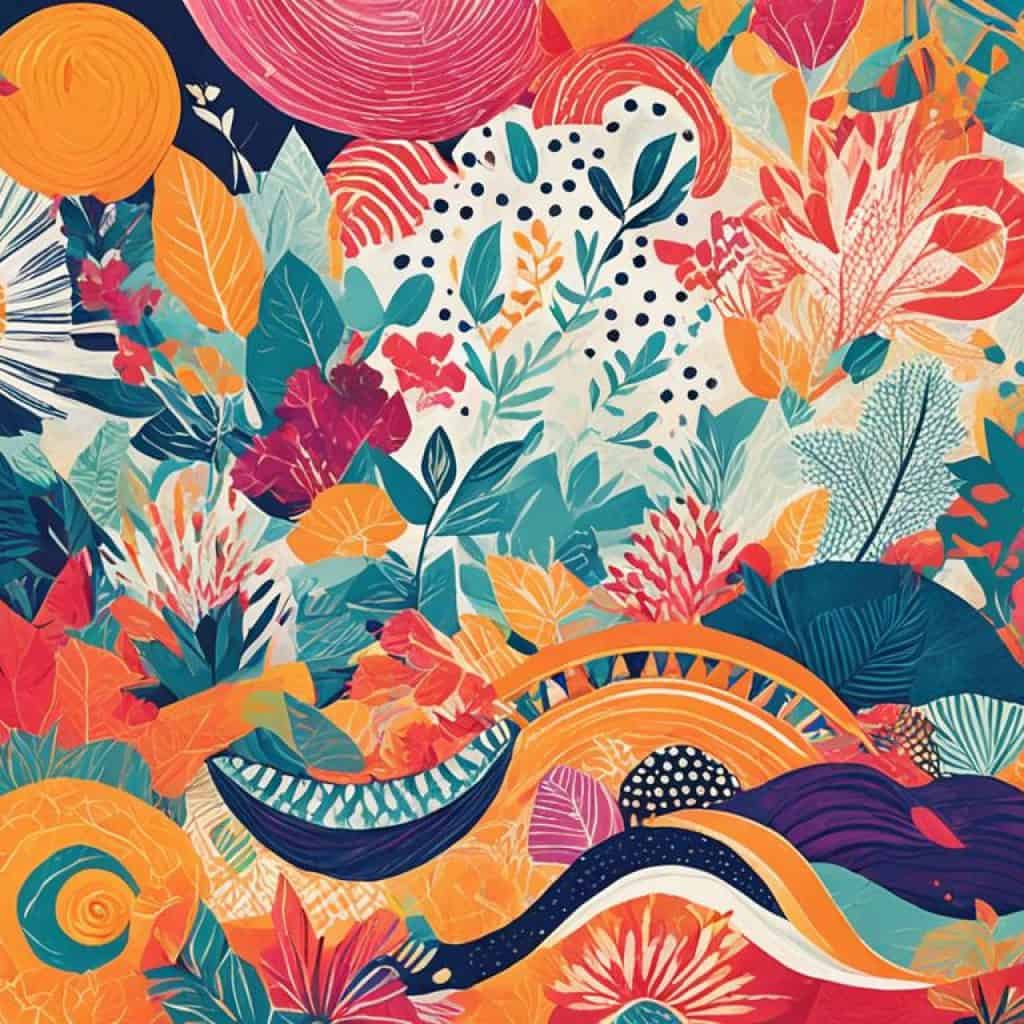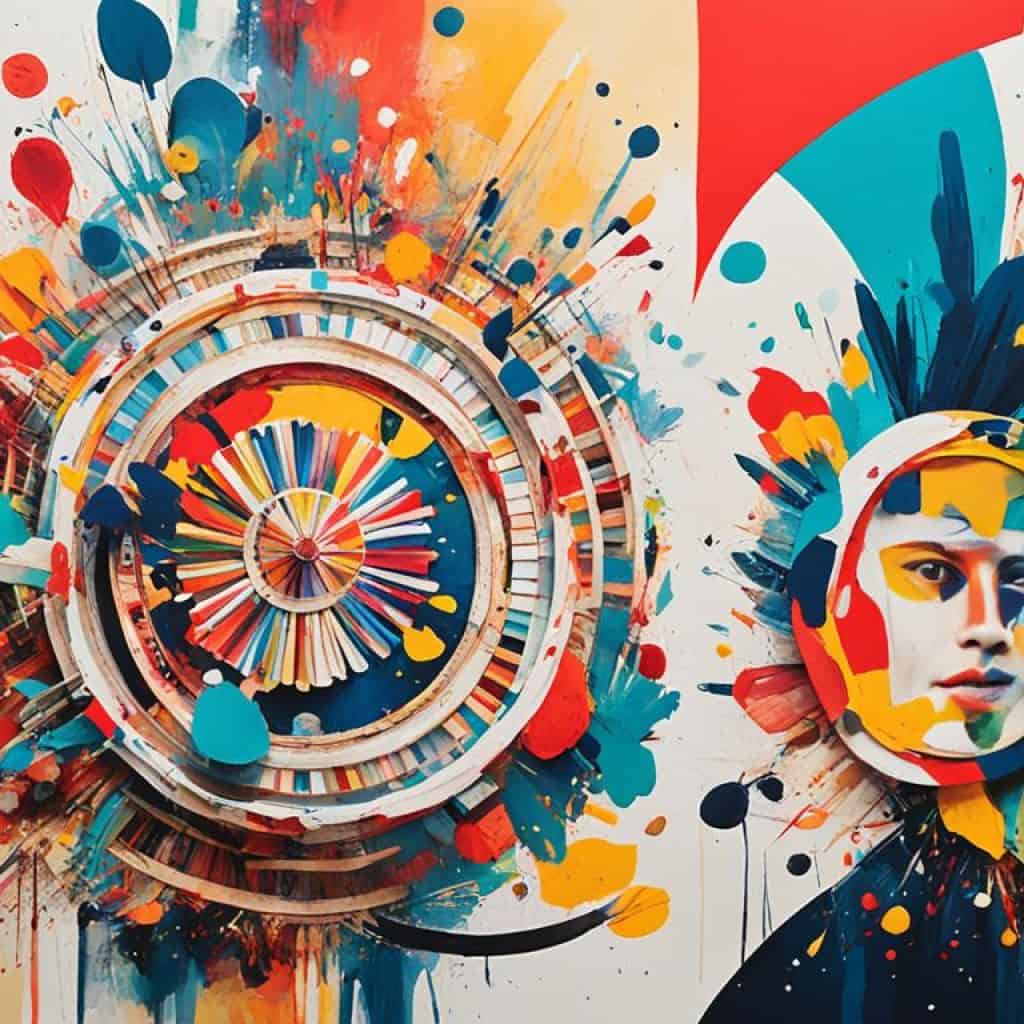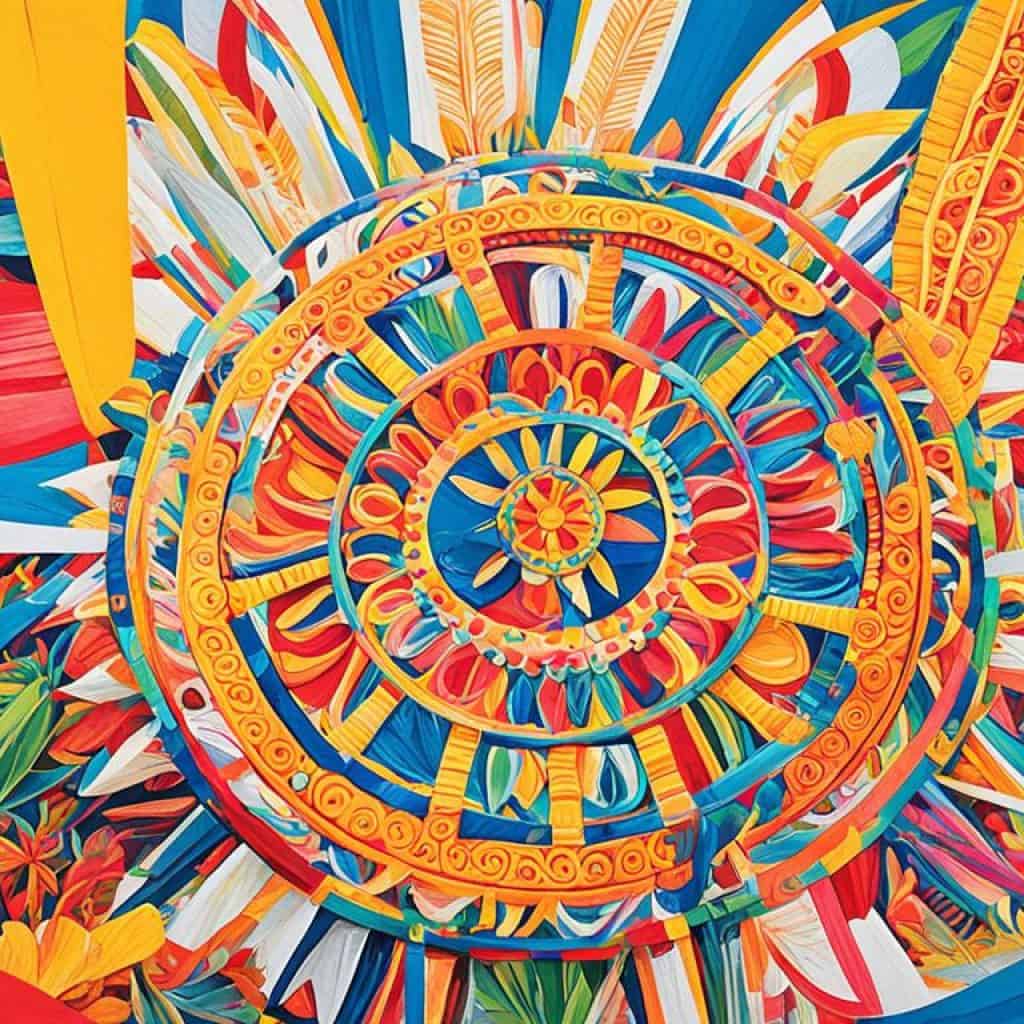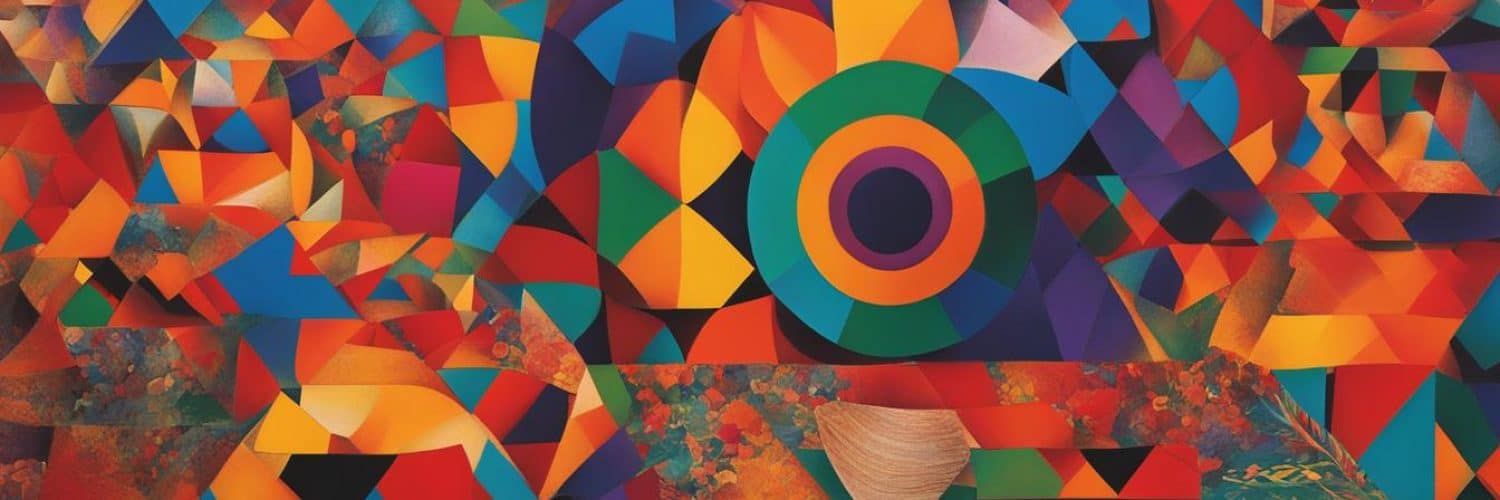Have you ever wondered how contemporary Filipino art combines traditional aesthetics with modern expression? Or how emerging artists in the Philippines are redefining the art scene in Manila? Join us as we delve into the rich tapestry of Philippine modern art, exploring the diverse styles, themes, and techniques that have shaped the vibrant art scene in the country.
Key Takeaways
- Contemporary Filipino art blends traditional aesthetics with modern expression.
- The art scene in the Philippines is dynamic and diverse, reflecting the country’s rich cultural heritage.
- Notable Filipino artists have made a significant impact on the global art stage.
- The Philippine contemporary art scene is shaped by various art movements, each contributing to its dynamic nature.
- Art galleries in Manila provide opportunities to explore and appreciate the vibrant Philippine contemporary art scene.
Overview of Philippine Contemporary Art
The Filipino art scene is a vibrant and dynamic landscape that reflects the rich history, diverse culture, and multitude of voices in the Philippines. From paintings to sculptures, installations to photography, contemporary art forms in the country cover a wide spectrum of mediums. What sets the Filipino art scene apart is its fusion of old and new, as artists seamlessly incorporate traditional elements from indigenous folk arts and colonial-era influences into their modern creations.
This fusion of old and new serves as a powerful platform for social commentary and critique. Filipino contemporary artists fearlessly tackle pressing societal issues such as politics, corruption, environmental concerns, and human rights through their art. They challenge the status quo, sparking conversations and raising awareness about crucial matters that impact the nation.
The Filipino art scene is known for its diversity and dynamism. Artists experiment with various styles, themes, and techniques, pushing the boundaries of artistic expression. This constant innovation and exploration further contribute to the multifaceted nature of Philippine contemporary art.
Philippine Contemporary Art Forms
Here are some of the contemporary art forms that flourish in the Philippines:
- Paintings: From traditional canvas paintings to experimental mixed-media creations, paintings remain a popular and expressive medium in the Filipino art scene.
- Sculptures: Sculptors craft captivating three-dimensional pieces using various materials such as wood, metal, stone, and even recycled objects.
- Installations: Installations provide immersive experiences, often utilizing various elements such as light, sound, and interactive components to engage viewers on a sensory level.
- Photography: Photographers capture meaningful moments, stories, and emotions through their lens, exploring diverse subjects and perspectives.
Through these art forms, Filipino contemporary artists create thought-provoking works that resonate with audiences both locally and internationally. These artworks serve as reflections of the Filipino people’s struggles, dreams, and aspirations.
Furthermore, the Filipino art scene welcomes a fusion of traditional and modern techniques and themes. This fusion embraces both the country’s rich cultural heritage and its forward-thinking spirit, resulting in truly unique and captivating artistic expressions.

As seen in the image above, this artwork exemplifies the fusion of old and new in Philippine contemporary art. The vibrant colors and dynamic composition showcase the artist’s creativity and mastery of technique.
Overall, the overview of Philippine contemporary art reveals a thriving art scene that boldly captures and reflects the country’s culture, history, and societal dynamics. Through their diverse and innovative works, Filipino artists continue to shape and contribute to the global art landscape.
Notable Philippine Contemporary Artists
The Philippine contemporary art scene is home to numerous artists who have made a significant impact on the global stage. These artists bring depth, diversity, and dynamism to the Philippine contemporary art scene. Let’s explore some notable Filipino artists who have garnered recognition for their exceptional work:
Benedicto Cabrera (Bencab)
Known for his captivating paintings, Benedicto Cabrera, or Bencab, is celebrated for his depictions of Filipino life, as well as the social and political landscape of the Philippines. His artwork beautifully captures the essence of the Filipino culture and has made a profound impact on the contemporary art scene.
Nona Garcia
Nona Garcia’s art is characterized by her photorealistic paintings and installations that challenge the notions of memory, identity, and personal histories. Her remarkable talent in capturing intricate details and creating thought-provoking visual narratives has earned her recognition both locally and internationally.
Elmer Borlongan
Elmer Borlongan’s vivid, realistic paintings offer a glimpse into the struggles and joys of everyday Filipino life. Through his skillful brushwork, he portrays the resilience and spirit of the Filipino people, elevating the ordinary and capturing the human experience in his artwork.
Patricia Perez Eustaquio
Patricia Perez Eustaquio is a versatile artist who explores themes of decay, desire, and the pursuit of beauty. Her body of work spans various mediums, including sculpture, painting, and textiles. Through her art, she delves into the complexities of human emotions and the fleeting nature of existence.
These notable artists, alongside many others in the Philippine contemporary art scene, continue to make waves with their creativity and unique perspectives. Their contributions enrich the art world and inspire us to appreciate and engage with contemporary Filipino art.

Prominent Art Movements in the Philippines
The Philippine contemporary art scene has been shaped by various prominent art movements that have influenced and brought diversity to Philippine modern art. These art movements have shaped the styles, themes, and techniques found within the Philippine contemporary art scene. Let’s take a closer look at some of these influential art movements:
Modernism in the Philippines
Modernism emerged in the mid-20th century and introduced abstraction, expressionism, and cubism to Philippine art. It challenged traditional artistic norms and paved the way for experimentation and innovation.
Neo-Realism in Filipino Art
Neo-Realism, which emerged in the late 20th century, portrayed reality with a new perspective. Artists focused on capturing everyday scenes and depicting common people as subjects, providing a fresh and relatable exploration of Filipino culture.
Post-Modernism in Philippine Art
Post-Modernism in Philippine art challenged conventional boundaries and embraced diversity and contradiction. It redefined notions of high and low art, blending various styles, genres, and mediums to create thought-provoking and visually striking artworks.
Conceptual Art in the Philippines
Conceptual Art emerged in the late 20th century, prioritizing ideas over visual components. Artists emphasized concepts, often using complex and intellectual approaches to critique social, political, and cultural issues. Conceptual Art pushed the boundaries of traditional art forms and encouraged viewers to think beyond the visual aesthetics.
These prominent art movements have contributed to the evolution of Philippine contemporary art, pushing boundaries, challenging norms, and providing platforms for artistic expression. They continue to inspire and influence artists, shaping the vibrant and dynamic art scene in the Philippines.

How to Appreciate Philippine Contemporary Art
Appreciating Philippine contemporary art is a personal journey that does not require expertise. Engaging with the artwork on a personal level allows you to discover its unique beauty and meaning. Here are some tips to help you appreciate and connect with Philippine modern art:
1. Observe and Explore:
Take the time to look closely at the artwork. Notice the colors, shapes, textures, and details that the artist has incorporated. Let yourself be immersed in the visual experience and allow the artwork to speak to you.
2. Reflect and Feel:
Consider what the artwork might be trying to convey and how it resonates with you. Reflect on the emotions and thoughts that the artwork evokes. Each piece of art has its own story and message, so allow yourself to connect with it on a deeper level.
3. Learn and Understand:
Learning more about the artwork, including the artist, context, and techniques used, can provide a deeper understanding of the piece. Research the artist’s background, influences, and artistic journey. Understanding the historical and cultural context surrounding the artwork can also enhance your appreciation for it.
4. Engage in Discussion:
Engaging in discussions about art with others can broaden your perspectives and enhance your art appreciation experience. Share your thoughts and interpretations with fellow art enthusiasts, visit art forums, and attend art workshops to gain insights from different viewpoints.
5. Embrace Individual Interpretations:
Remember that art is subjective and open to interpretation. Each individual may have a different understanding and emotional response to a particular artwork, and that is part of the beauty of art. Embrace the diverse interpretations and open your mind to new perspectives.
“Art enables us to find ourselves and lose ourselves at the same time.” – Thomas Merton
By following these tips and engaging with Philippine contemporary art, you can develop a deeper appreciation for the unique expressions of Filipino artists and their contributions to the art world.
Prominent Art Galleries and Museums in the Philippines
The Philippines is a treasure trove of art galleries and museums that showcase the rich and diverse contemporary art scene in the country. Whether you are a local or a visitor, these art venues in Manila are a must-visit for art enthusiasts and those seeking to experience the vibrant art culture of the Philippines.
| Art Gallery/Museum | Location | Description |
|---|---|---|
| Metropolitan Museum of Manila | Manila | The Metropolitan Museum of Manila, also known as the Met, is a haven for art aficionados. Showcasing exhibitions featuring prominent Philippine contemporary artists, the Met provides a platform for artists to express their creativity and contribute to the country’s art scene. |
| Cultural Center of the Philippines (CCP) | Manila | As a premier cultural and arts hub, the Cultural Center of the Philippines not only hosts various performing arts events but also features galleries that display the works of established and emerging artists. Immerse yourself in the diverse art forms found within the walls of the CCP. |
| Ateneo Art Gallery | Ateneo de Manila University, Quezon City | Nestled within the Ateneo de Manila University campus, the Ateneo Art Gallery houses an impressive collection of Philippine contemporary art. Explore the artworks created by talented Filipino artists and gain insights into the country’s rich artistic heritage. |
| Pinto Art Museum | Antipolo, Rizal | Escape the bustling city and head to Antipolo to discover the Pinto Art Museum. Set amidst lush gardens and inspired by Greek architecture, this museum offers a unique cultural experience. Marvel at the vast collection of contemporary artworks by Filipino artists and immerse yourself in the beauty of Philippine art. |
These prominent art galleries and museums highlight the exceptional talent and creativity of Filipino artists. Visiting them provides an opportunity to explore the vibrant Philippine contemporary art scene and appreciate the diverse range of artworks on display. Whether you are interested in paintings, sculptures, or installations, these art venues have something to captivate and inspire every art lover.
Impact of Philippine Contemporary Art in Society
Philippine contemporary art has a profound impact on society, influencing various aspects of culture, perception, and economics. It serves as a powerful medium through which artists reflect social issues and provide commentary on pressing societal matters, making it a mirror of society itself.
Contemporary art prompts critical thinking and encourages viewers to question and explore different perspectives. By engaging with thought-provoking artworks, individuals can broaden their understanding of societal issues and develop empathy towards different experiences.
Artists in the Philippines often incorporate elements of traditional Filipino art forms, promoting cultural heritage and preserving the country’s rich artistic legacy. This fusion of old and new creates a unique cultural influence in Philippine contemporary art, attracting both local and international audiences.
“Art enables us to find ourselves and lose ourselves at the same time.” – Thomas Merton
Furthermore, the economic contributions of Filipino art are significant. The sale of artworks, admission fees to galleries and museums, and art tourism all contribute to the growth of the economy. The vibrant art scene in the Philippines attracts art enthusiasts, collectors, and tourists, stimulating local businesses and fostering a thriving creative ecosystem.
The Societal Impact of Filipino Modern Art
Philippine contemporary art evokes emotions, sparks conversations, and challenges societal norms. It encourages individuals to think critically, fostering a society that values diverse perspectives and embraces dialogue.
The art serves as a powerful tool for social activism, addressing issues such as inequality, human rights, environmental degradation, and political corruption. Through their artistic expressions, Filipino modern artists shed light on the struggles, hopes, and experiences of the people, amplifying marginalized voices and initiating conversations for change.
The Cultural Influence of Philippine Contemporary Art
Philippine contemporary art extends beyond the boundaries of the art world, shaping societal perceptions, values, and cultural identity. By incorporating elements of traditional Filipino art forms, artists preserve and promote cultural heritage while infusing it with modern interpretation.
The cultural influence of Philippine contemporary art is felt both locally and globally. Internally, it strengthens a sense of national identity and collective memory. Externally, it showcases the artistic talent and rich cultural heritage of the Philippines, gaining recognition and appreciation on the global stage.
Future of Philippine Contemporary Art
The future of Philippine contemporary art is filled with exciting possibilities and new directions. As technology advances, one emerging trend in Filipino art is the exploration of digital mediums. Artists are venturing into digital painting, creating immersive virtual reality installations, and embracing other innovative forms of digital art. This intersection of technology and creativity opens up endless possibilities for artistic expression and experimentation.
Another promising aspect of the future of Philippine contemporary art is the potential for artistic collaborations. Renowned Filipino graffiti artists, alongside visual artists, are coming together to create captivating and innovative works that transcend traditional boundaries. These collaborations bring together different artistic perspectives and expertise, resulting in dynamic and thought-provoking pieces that challenge societal norms and push artistic boundaries.
The global recognition of modern Filipino art is also continuing to grow. Artists from the Philippines are gaining attention and acclaim on the international stage, with their unique artistic visions and narratives resonating with audiences worldwide. This growing global recognition provides more opportunities for Filipino artists to showcase their work, further establishing the Philippines as a hub of contemporary art and creativity.
Through digital art exploration, artistic collaborations, and global recognition, the future of Philippine contemporary art holds great promise. It is a future of continued innovation, where traditional and modern art forms converge, cultural boundaries are pushed, and new artistic narratives are created.
Conclusion
The Philippine contemporary art scene showcases the dynamic fusion of traditional Filipino aesthetics and modern artistic expression. Artists in the Philippines skillfully combine indigenous folk arts and colonial-era influences with modern techniques and themes, resulting in a vibrant and diverse art landscape. Serving as a platform for social commentary and critique, contemporary Filipino art reflects and addresses pressing societal issues while promoting cultural heritage.
The notable artists in the Philippine contemporary art scene have gained recognition on a global scale, contributing to the country’s rich artistic legacy. Influenced by various art movements, the art scene in the Philippines constantly evolves, embracing new ideas, styles, and techniques. Prominent art galleries and museums in Manila provide ample opportunities for art enthusiasts to appreciate and explore the captivating world of Philippine contemporary art.
The impact of Philippine contemporary art extends beyond the art world, influencing society, culture, and the economy. It acts as a mirror that reflects the struggles, hopes, and experiences of the Filipino people. Moreover, it plays a crucial role in preserving and promoting cultural heritage, fostering critical thinking, and shaping societal perceptions. Looking to the future, the Philippine contemporary art scene holds great promise for further innovation, collaborations, and global recognition.
As an important and vibrant facet of the global art landscape, modern art in the Philippines offers fresh perspectives, narratives, and visual experiences that resonate with audiences worldwide. By embracing the complexities of Philippine culture and exploring the narratives of emerging Filipino artists, the world can gain a deeper understanding of the rich heritage and diverse artistic expressions that the country has to offer.


















Add comment